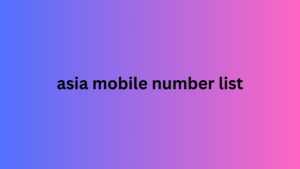Incorporating anchor text effectively into your SEO strategy can significantly enhance your ranking for long-tail keywords. Anchor text plays a crucial role in improving how search engines interpret and rank your content. For those aiming to boost their website’s visibility using long-tail keywords, understanding the right techniques for using anchor text is essential. This article will explore the best practices for incorporating anchor text to improve long-tail keyword ranking.
1. What is Anchor Text and Why Does It Matter for Long-Tail Keywords?
Anchor text refers to the clickable words or phrases within a hyperlink. When done correctly, anchor text helps search engines understand the context and relevance of the linked page. For long-tail keywords asia mobile number list, anchor text is an excellent way to indicate to search engines what the linked page is about, helping it rank higher for specific queries.
Search engines like Google use anchor text to establish a relationship between pages. Therefore, using relevant anchor text for your long-tail keywords signals to Google that your content is valuable for those specific, often niche, search terms.
2. Best Practices for Using Anchor Text with Long-Tail Keywords
Keep It Natural
The first rule of thumb when using anchor text is to ensure it reads naturally. Overstuffing your anchor text with long-tail keywords can be seen as spammy by search engines. Instead how to use anchor text to rank for informational and transactional long-tail keywords, aim for a smooth, natural flow of words that fits within the context of the content.
Use Descriptive, Specific Anchor Text
For long-tail keywords, specificity is key. Instead of using generic anchor text like “click here,” opt for phrases that closely mirror the search query. For example, if your long-tail keyword is “best marketing strategies for small businesses,” your anchor text should reflect this, such as “effective marketing strategies for small business growth.”
Balance Exact Match and Partial Match Anchor Text
While it is important to use long-tail keywords in anchor text, using exact matches too frequently can trigger a penalty for keyword stuffing. Instead, diversify the anchor text by using partial matches, synonyms, and related terms. This way, you make your content look more natural while still optimizing for relevant keywords.
3. Where to Place Anchor Text for Maximum Impact?
Internal Linking
Internal linking helps search engines understand the relationship between different pages on your website. By using anchor text for long-tail keywords, you can improve the ranking of those pages. When placing anchor text internally, choose a page that naturally complements the keyword you’re linking to.
External Linking
Linking to high-quality external websites with well-optimized long-tail keywords can also help improve your page’s ranking. When using anchor text for external links, ensure that the anchor text is relevant to the content you’re linking to, thus boosting the authority and relevance of your site.
Contextual Placement
The placement of anchor text within the content is important. Ideally, anchor text should be included in the body of the text where it fits naturally, rather than in navigation menus or footers. Content that provides value, such as blog posts or informative articles, is the perfect place to incorporate long-tail keyword anchor text.
4. Tracking and Measuring Results
Once you’ve implemented anchor text for long-tail keywords, it’s essential to monitor the results. Use tools like Google Search Console, SEMrush, or Ahrefs to track the performance of your pages and keywords. Look for improvements in rankings phone number es, organic traffic, and click-through rates to determine whether your anchor text strategy is working.
Adjust Your Strategy
If certain long-tail keywords aren’t performing as expected, consider tweaking your anchor text or revisiting the content around those keywords. SEO is an ongoing process, and regularly reviewing your strategy ensures you’re adapting to any changes in search engine algorithms.







